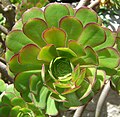| Tree aeonium | |
|---|---|
 | |
| Scientific classification | |
| Kingdom: | Plantae |
| Clade: | Tracheophytes |
| Clade: | Angiosperms |
| Clade: | Eudicots |
| Order: | Saxifragales |
| Family: | Crassulaceae |
| Genus: | Aeonium |
| Species: | A. arboreum |
| Binomial name | |
| Aeonium arboreum | |
| Synonyms [1] | |
| |
Aeonium arboreum, the tree aeonium, [2] tree houseleek, or Irish rose,[ citation needed ] is a succulent, subtropical subshrub in the flowering plant family Crassulaceae.









